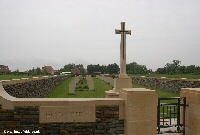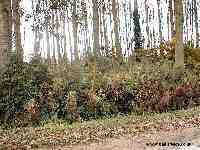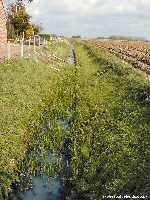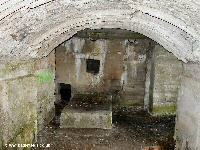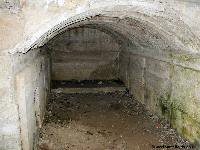Neuve Chapelle
The World War One Battlefields site is undergoing a major update, with pages being converted to a new, user-friendly mobile format. The updated pages can be found at Updated World War One Battlefields. Some pages such as this one remain in the original format pending update.
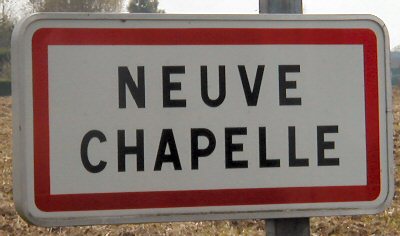
The 90th Anniversary of the Battle of Neuve Chapelle passed in March 2005 with little comment or noitice. I was in Neuve Chapelle on the 90th Anniversary, and there were no other visitors at the Indian Memorial, nor did I see any other battlefield visitors on what was a cold and grey 12th of March, 2005. Perhaps the Centenary of the batlle will be marked with a little more ceremony.
Yet this short, and (in terms of what was to come later) small offensive, which took place on the 10th to the 12th of March 1915, whilst not well remembered todayis nonetheless important for several reasons.
Firstly, after the period of movement that followed the outbreak of the First World War in 1914, Neuve Chapelle was the first set-piece offensive battle undertaken by the British from static trenchlines. Trench warfare, although not seen for the first time in the First World War, was new to many of the soldiers and the staff officers. Hence, this battle was the first time that several innovations were used, such as timed lifts of barrages. Although it was small in concept and numbers, many lessons were learnt and subsequently used to better advantage. Neuve Chapelle was where the British started to learn the hard lessons that led to the practices undertaken in many if not all subsequent offensives.
The Battle of Neuve Chapelle
Neuve Chapelle is a small village located roughly midway between Bethune and Lille, and is around 20 miles south of Ypres. This first British set-piece attack of the War was planned here early in 1915 by Douglas Haig, at that time in command of the First Army. The intention was to initially capture the German lines in this German salient, then the village itself, and then drive through onto the nearby Aubers Ridge, where the high ground had the usual strategic value. If this was acheived, the enemies lines of communication between La Bassee and Lille could also be disrupted.

Location of Neuve Chapelle
In terms of forces, the British had a clear superiority. The six Divisions of Haig's First Army along the 13 miles it then held faced only two Divisions of the German VII Corps. Not all these forces were involved at Neuve Chapelle: the Order of Battle for the Battle of Neuve Chapelle shows the units from both sides which were involved. The attack was carried out by units from the 7th, 8th and Indian Divisions
The intention was, for the first time, to use a set "lifting" barrage timetable, such that the guns would concentrate on one target, then lift at a pre-determined time to the next one, whilst the infantry simultaneously moved forward to take the objective that had just been pulverised. A detailed timetable and target list was issued to the batteries involved. Although the artillery were limited by a lack of ammunition, the concentration of batteries around Neuve Chapelle was impressive, although it paled almost into insignificnace (in terms of total numbers) compared with later battles. From the Official History, there were 530 guns or howitzers available to the First Army, with over 216,000 artillery rounds for these guns, making an average of over 400 rounds per gun. Please click here for a detailed artillery breakdown for the Battle of Neuve Chapelle.
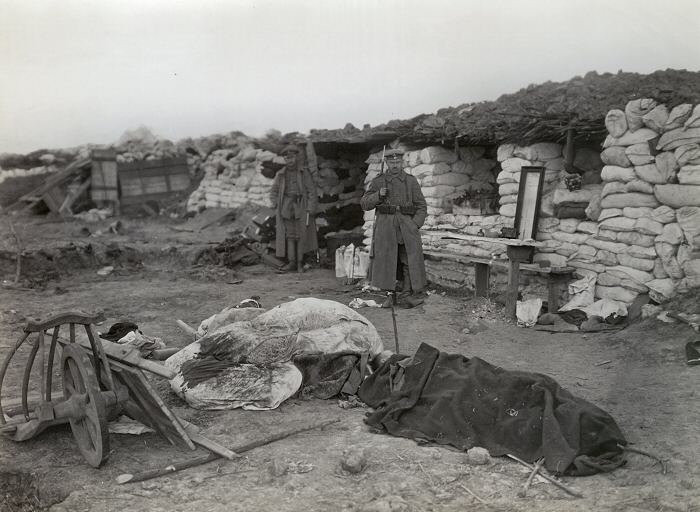
British wounded in German trenches near Neuve Chapelle
Other innovations were also first tried here: maps were issued, which had marked on them the objectives to be taken (in terms of Red line, Blue line and so on). Plans were put in place for a concurrent bombing programme by aeroplanes, and this was carried out on the first day of the battle, although poor weather prevented this from being carried through on later days. Effective secrecy about the forthcoming attack was maintained extremely well, as surprise was acheived on the day of the offensive.
In fact, as the Official History states, all subsequent offensives were based on the methods developed by the First Army for Neuve Chapelle. Obviously, refinements and changes, seen as improvements, were introduced, and the offensives of later in the War had developed enormously from Neuve Chapelle. It should be remembered that the Commander of the First Army was Sir Douglas Haig, who has been portrayed many times as a bungler and a donkey; and yet it was he and his staff with little or no previous experience of trnch warfare to draw on who put together the plans for this operation which showed many innovations and was in many ways a qualified success (albeit with probably too optimistic intial objectives).
The Barrage
By 4.30 a.m. on the 10th of March, 1915, all the troops were in their positions, and before their arrival the men already in the line had prepared by vacating trenches, but not before setting up ladders for exiting the trenches and placing footbridges over ditches in the path of the attack.
Sunrise was at 6.30 a.m., and at 7.30 a.m. the artillery commenced their barrage. Their first task was to clear paths through the German wire, which was six to fifteen yards in depth here. Wire-cutting, unlike in 1916 on the Somme, was reported to be effective in most places. At the same time, guns and howitzers opened up on the German front-line trenches. These trenches were not deep, and were in fact built up some four feet high from ground-level with breastworks of sand-bags about five feet across. This phase of the bombardment lasted 35 minutes, with around 3000 shells fired - mostly with good results. A portion of the German front-line on the left hand of the attack front was not seriously damaged, due at least in part to the late arrival of some of the heavy artillery.
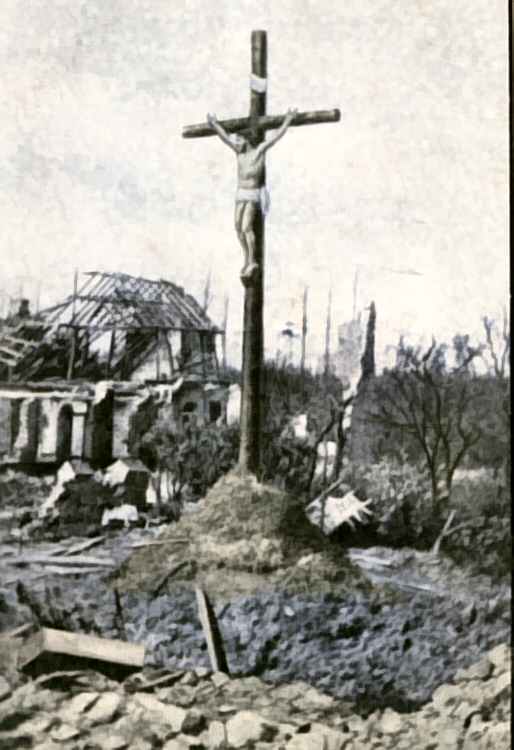
A Crucifix at Neuve Chapelle still standing amidst the ruins. Photo: Photocrom
At 8.05 a.m., after the 35 minute initial barrage, the artillery lifted their sights 300 yards further east, and commenced shelling the next objectives including the village of Neuve Chapelle as per the arranged timetable. For the infantry waiting in the trecnhes, the attack would now commence.
The Infantry Attack
In most areas, the first phase of the infantry attack went well, with the troops rapidly gaining the enemies front-line trenches, and the village itself within 45 minutes. However, there were failures both to the north (where the initial bombardment had not been effective) and to the south (where the attacking troops set off at a tangent to their planned objectives, and thus came up against sectors of the enemy trench which had not been bombarded and were well defended.
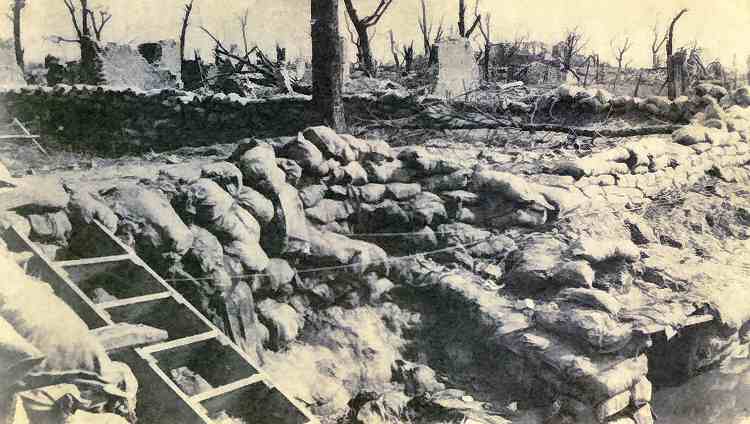
Trenches in the village. Photo: Visa Paris
However, as the day progressed, the attack was held up; partly by problems with communications (especially between units of different brigades and Divisions) and partly because of mistaken intelligence (for example it was thought that an orchard in the northern part of the battlefield was strongly defended whereas in fact it was not held by the enemy at all). The Germans, who had been taken by surprise, were able to bring up reinforcements and mount counter attacks over the next two days, and although reports of operations cover the 10th - 14th March, the Battle is officially considered as just the three days of 10th, 11th and 12th. The casualty figures for the British were around 3,500 killed and 8,500 wounded. German casualty figures are more diffuicult to come by, but must have also run into thousands.
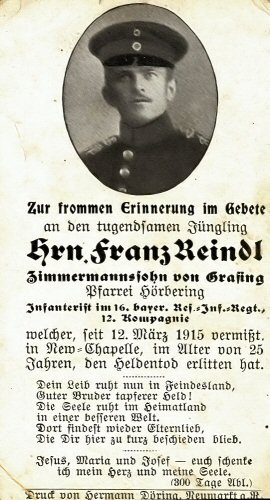
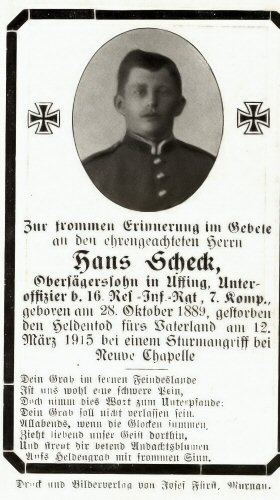
Deathcards of two German soldiers who died at Neuve Chapelle
The gains made were significant, but not spectacular, and the salient had been flattened out. However, the Aubers ridge had not been reached, and neither had the Bois du Biez, which had been one of the secondary objectives.
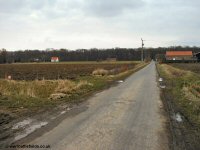
The Bois du Biez - a first day objective
Hence, it did not prove possible to make the breakthrough which Haig had hoped for, and the cavalry (who were waiting to expliot this) were not required. However, the initial attack pioneered several new innovations that were required now that trench warfare was here to stay. The battle highlighted what now seems obvious: without modern communications, once an attack of any size was launched, the senior commanders were effectively helpless. Little information comes in, and what there is may be incorrect, out of date or just wrong. However, the initial successes were greatly encouraging, and the battle proved the British committment to the war to their French allies. There are many positives from the Battle of Neuve Chapelle, and it is a shame that the 90th anniversary passed without apparently any commemoration. I hope that when the 100th anniversary arrives in 2015, it will be marked appropriately.
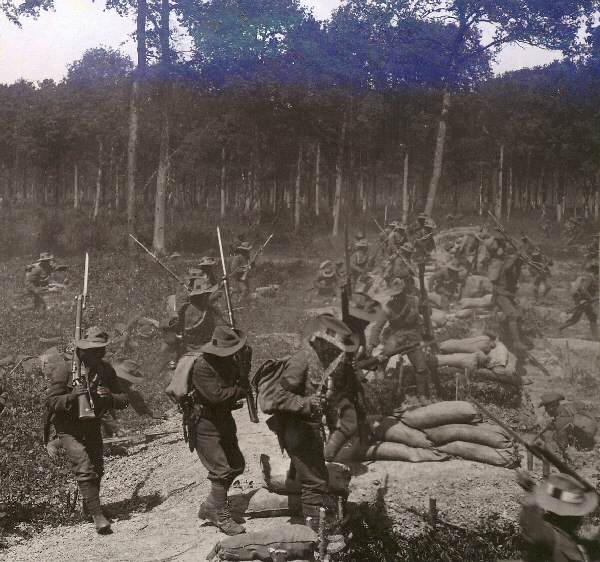
Ghurkas near Neuve Chapelle. Photo: Realistic Travels
The battlefield of Neuve Chappelle is not well known or visited, but there is much of interest to see there, and the rest of this page gives some information on visiting and what there is to see today.
The Indian Memorial
The imposing Indian Memorial is located at a roundabout on the main D947 road to the south-east of the village. This is where the D171 (Rue du Bois) crosses the main road. It is actually on the site which was marked as Port Arthur on trench maps. There was a small bulge in the lines here, which meant that this was a little further behind the front lines than was the case further north and south along this road. Consequently, at the start of the battle, the battalion Headquarters of the 1/39 Garwahl Rifles was based here.
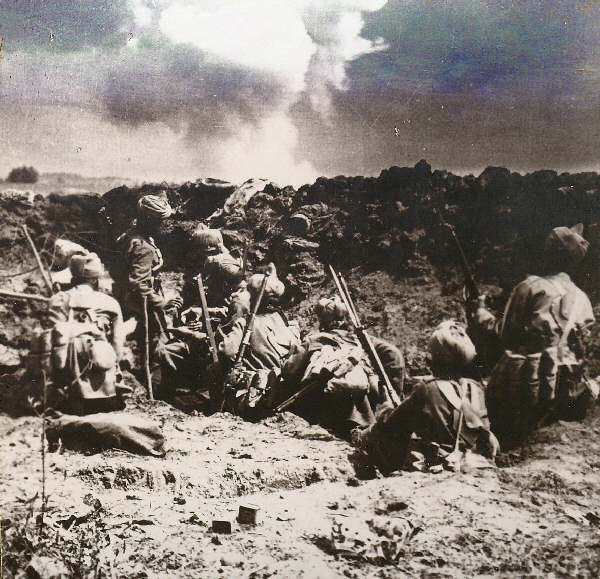
Indian soldiers at Neuve Chapelle. Photo: Realistic Travels
The plans to commemorate the 1st of July 2006, and the 31st of July 2007, the 90th Anniversaries of the start of the Somme and Third Ypres battles respectively are well in hand and well publicised. However, on the 90th Anniversay of the start of the battle of Neuve Chapelle, there was no commemoration at the Indian Memorial, and during the day I didn't see another battlefield visitor. The CWGC gardeners were working at the Indian Memorial, continuing their invaluable work to maintain the memorial, but there was no commemoration of the 90th anniversary of this sadly forgotten battle.
However, the Indian Memorial itself maintains the memory of those of the Indian brigades, battlaions and regiments who fought and died here. The first picture below shows the Memorial seen from across the roundabout which now exists at Port Arthur. The larger picture is a view of the memorial either when it was first erected (scaffolding can be seen around the right hand cupola) or shortly afterwards.
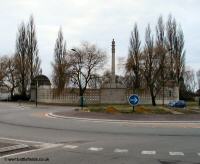
The Indian Memorial at Port Arthur
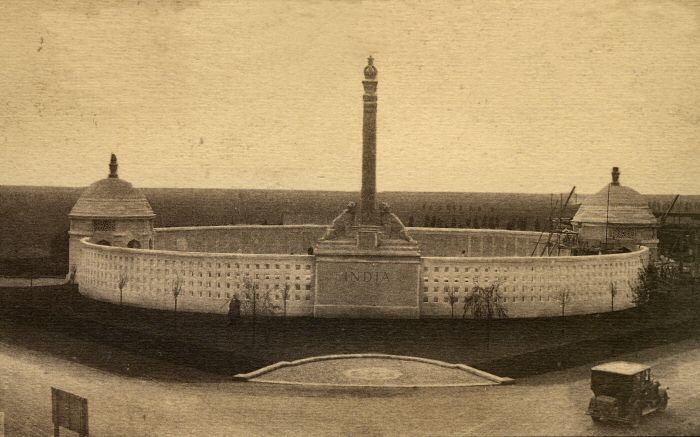
View of the Indian Memorial during construction. Photo: Lucien Pollet
The memorial is in the form of a circular enclosure, with a 15 metre tall column, which is flanked by two tigers, dominating. The column recalls the pillars of Asokar, and the column shows the Lotus Capital, the Star of India and the Imperial Crown. The word "India" and "1914 - 1918" is inscribed on the stone at the base of the column.
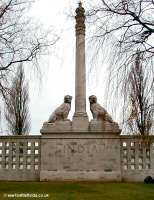
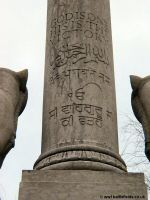
The Column at the Indian Memorial at Neuve Chapelle
On the other side the battle honours of Indian Units which served on the Western Front are listed, as shown in the photo below (which can be enlarged by clicking on it).
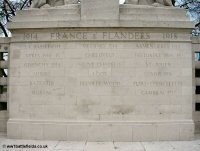
The Indian Memorial at Neuve Chapelle
The wall on the far side from the column is engraved with the names of 4743 soldiers of the Indian Army who have no known grave. The inscription in the picture below commemorates them with the words "To the honour of the Army of India which fought in France and Belgium 1914-1918 and in perpetual rememberance of those of their dead whose names are here recorded and who have no known grave."
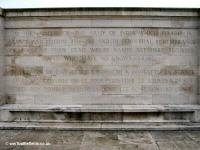
The Inscription at the Indian Memorial
The memorial itself was constructed in 1927, but more recently, in 1964, a bronze plaque was added to commemorate another 210 Indian servicemen who died after being captured during the War, and were buried at Zehrensdorf south of Berlin. There was a large prisoner of war camp near Zehrensdorf at Zossen, and these men were buried in the Cemetery. However, as this was located in what was then East Germany during the Cold War, the CWGC could not access and maintain the graves, and so the names of those buried there were recorded and commemorated here. The bronze plaque is shown below.
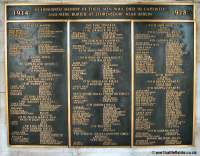
The Memorial to soldiers buried at Zehrensdorf, whose graves are now recovered (see below)
Recently, in what is an excellent development, the cemetery at Zehrensdorf has been reinstated on the CWGC list of official cemeteries. This followed CWGC and local efforts to rescue the cemetery, in an area that had been used as part of a Soviet tank training ground after the Second World War. The Duke of Kent, President of the CWGC, officially rededicated the recovered cemetery on October 29th 2005. These efforts by the CWGC and the local people of Germany mean that these men can now be honoured in their final resting place after 90 years, and at some point in the future the Cemetery will be listed on the CWGC on-line searchable database, and presumably the plaque currently at Neuve Chapelle will be removed. The CWGC has also commissioned a panel for Zehrensdorf Cemetery, and further news on this develoopment will be added here.
Situated just outside the Indian Memorial itself is a stone memorial to 2/Lt Cyril Alfred William Crichton, of the 3/London regiment who was killed near here on the first day of the Battle of Neuve Chapelle. The memorial was moved from it's original location (which was nearer the cafe on the other side of the roundabout) to here in 1965. It was damaged during the Second World War and has also been hit by a car in the past. 2/Lt Crichton's body was found in 1925, and he is now buried in Le Touret Cemetery.
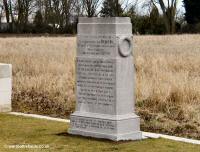
Memorial to 2nd Lieutenant Crichton
About 100 yards south of the Indian Memorial on the D947 is the Portugese Cemetery and Memorial. This is not a wartime cemetery; it was begun in 1924 by bringing in the remains of Portugese soldiers from a number of other cemeteries in Belgium and France. There are nearly 2,000 burials, and there is a small chapel. It was the Portugese soldiers (during the Battle of the Lys in 1918) who took the "Christ of the Trenches" into their positions with them. The figure is now in Portugal commemorating Portugal's Unknown Soldier.
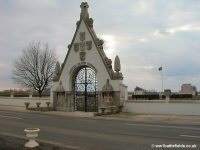
The Portuguese Cemetery at Neuve Chapelle
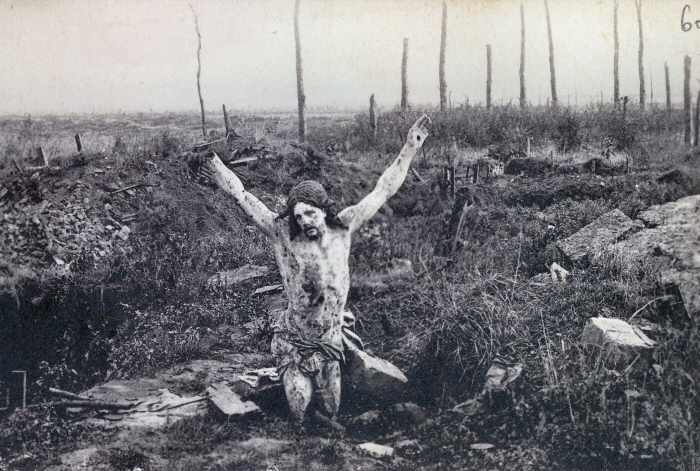
The "Christ of the trenches".
Driving north from the Indian memorial, the British front lines before the Battle of Neuve Chapelle were located just to the left of and parralell with this road (the D947) until the next left turn (the Rue des Haies). The countryside around is very flat and faetureless. The next turn right off the D947 is the site of Pont Logy (marked on modern maps as Peit Logis). Once again, being behind the British lines this was the site of unit headquarters, and the 25th Brigade HQ was located here at the beginning of the battle of Neuve Chapelle. As the initial advances were successful, Brigadier-General Lowry-Cole moved his HQ forward to try and maintain touch with the action.
Turning right at Pont Logy onto the D170 takes you now to the north-west of the village, and the British lines ran about 300 yards parrallel to the right of this road. The first right turn (Rue du Moulin), leads towards the centre of the village. The second right (marked on maps today as Rue des Cheminees but known to the soldiers and marked on British maps as Signpost Lane) is more or less along the line that marked the Divisional boundary between the 7th and 8th Divisions for the Battle. It was along this boundary (between the 25th Brigade of the 8th Division and the 23rd Brigade of the 7th Division) that there was some confusion that Haig later was to cite as part of the problems that followed the initial successes in the battle. The 23rd Brigade (on the left) were held up which left the flank of the 25th Brigade exposed. The 2/Lincolns were on the left of the 25th Brigade (and thus the 8th Division) frontage, and their War Diary and report on the battle make fascinating reading.
Continuing along, the D170 takes a sharp right, and then joins the D171, now just about due north of the village itself. There is a track that continues on: this was one of the Sunken Roads (named as such on the map) that are found on many parts of the Western Front in France. The road here crosses the position of the British front lines before the battle in March 1915, and the left-hand picture below shows the view from the position of the line, looking in a southeasterly direction towards the German front line position. In the distance the road joins the D171 and bears left, and the Sunken Road (no loner sunken) continues straight on as a track. The right hand picture below shows the view, again looking south-east, from approximately where the German linews were before the start of the battle. The heights of Aubers ridge can be seen in the background, particularly in the right-hand picture.
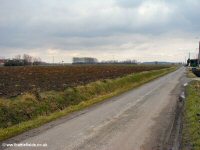
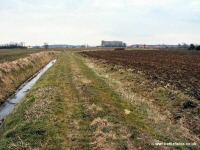
The view from the Sunken Road looking SE from the British (left) and German (right) front lines positions
Joining the D171 and continuing in a NE direction past the Sunken Road, around another 150 yards, you reach the site of another significant location on the 1915 battlefield: the Moated Grange. This site (properly the Ferme Vanbesien) had already been involved in action in November and December 1914, and in fact had largely been destroyed on the 27th of November 1914 to remove the threat of German snipers. This was the extreme left of the British attack frontage in March 1915, and the Moated Grange was at that time mainly in No Mans Land between the British and German lines (although some of the German trenches passed through the southern edges of the remains of the buildings). The current building is not the original as that was destroyed during the War, but the remains of the moat can still be seen on both sides of the building.
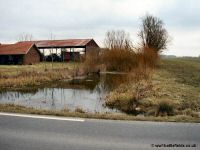
The site of the Moated Grange today
Between here and the Sunken Road, the attack was delayed in the mistaken belief that there were German strongholds in an orchard which then stood there. It was only just after noon that the remains of the 2/Middlesex (which had suffered badly earlier in the day) and companies of the 2/West Yorks advanced to find the Orchard unoccupied, and not even fortified or prepared for defence. The 2/West Yorks then moved a little north to capture the German lines around the Moated Grange, but the delay in taking the Orchard was later seen as a significant factor in how the battle progressed.
Continuing on the D171 past the Moated Grange and over a crossroads on the left of the road is Fauquissart Military Cemetery. This is a small (105 burials), original cemetery; the first row of graves dating from November and December 1914 when the Cemetery was begun by the 2nd Royal Berks and 2nd Rifle Brigade. It was in use until June 1915. The graves are laid out from the front to the back almost in a chronological order of date of death. The majority are from late 1914 and January 1915.
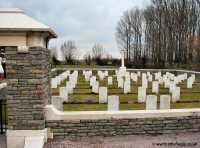
Fauquissart Military Cememtery just outside Neuve Chapelle
There are several burials from the Battle of Neuve Chapelle, including Captain Charles Edmund Wood, a Harrow and Sandhurst educated soldier who was Adjutant of the 1st Battalion Royal Welsh Fusiliers, killed on the 11th of March 1915. There are special memorials to three men known to be buried in the Cemetery (there are 19 unidentified graves), and one of these, Lance-Corporal F E Carter of the Northamptonshire Yeomanry also died during Neuve Chapelle. His marker stone is picture below. The inscription reads "A noble son, his Country called, he answered".
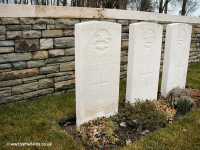
FE Carter who fell during Neuve Chapelle.....known to be buried in Fauquissart Military Cememtery
If you return to the crossroads in the direction of the Moated Grange, but turn left at the crossroads towards Neuve Chapelle, you will cross the position of first the British and then the German front lines as they crossed the road here. Just beyond the German lines and to the right of the road (about 300m from the cross-roads) was a German strongpoint known as the Quadrilateral. The road bends sharply right, then left, and a right turn leads towards the village. This was largely destroyed during the War, and the picture below shows the scene of desolation in the village after the battle.
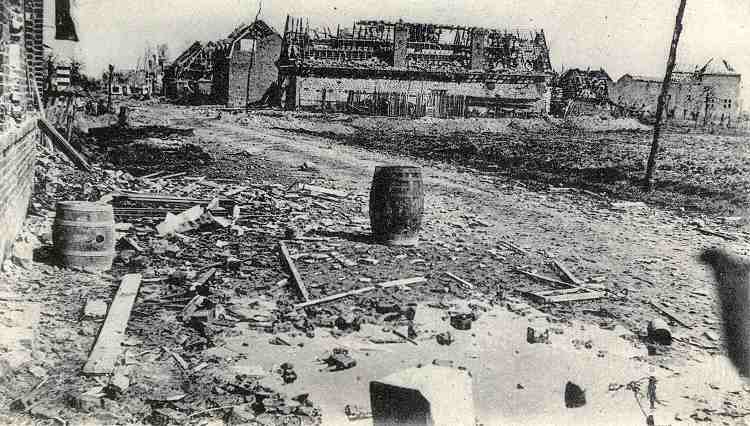
A street in Neuve Chapelle after the battle. Photo: Visa Paris
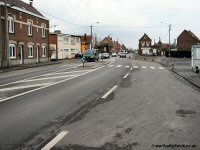
The main street in Neuve Chapelle today
There are many new buildings in the area. In the centre of Neuve Chapelle village is the church, and next to it the Marie. Inside the church are signs in brickwork showing the dates 1924 and 1927. A figure of Christ can be seen high above the aisle. It clearly bears the scars of shrapnel or similar wartime damage. This figure dates from before the First World War, and originally stood on a crucifix outside the church. After the War it was placed in the rebuilt church. It is not the same figure as the "Christ of the Trenches" described above.
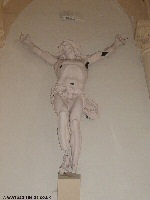
The war-scarred Christ in Neuve Chapelle Church
Also in the church is a brass cross which commemorates Lieutenant Pilcher who was originally buried in the churchyard after the battle of Neuve Chapelle. The inscription on the base of the cross reads "In loving memory of Lieut. Thomas Percy Pilcher of 2nd Batt. Rifle Brigade aged 21, and of his fellow Officers and men who fell valiantly attacking the German lines near Neuve Chapelle on March 12th 1915." The cross is positioned between two tablets commemorating the civilian and military casualties of Neuve Chapelle village itself (i.e. the French inhabitants). Pilcher and other officers of the 2/Rifle Brigade are commemorated by special memorials in Neuve Chapelle British Cemetery (see below).
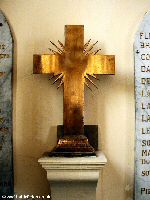
Cross commemorating Lt. Pilcher in Neuve Chapelle Church
Outside and to the rear of the church is a memorial which is supposed to be the orignal base of the crucifix on which the figure of Christ now within the church stood. It even has a shell embedded in it's side. Today the whole structure is concreted, although the rings around the base of the shell can still be seen. The small cairn on which this stabnds is dedicated to the local Abbe until 1912, Lefebvre.
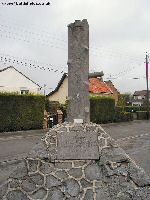
The memorial outside the church
Just to the right of the church stands the Marie. Inside can be seen some interesting displays of relics which have been found in and around the village.
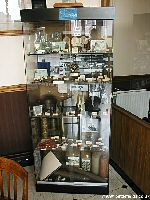
The display of finds in the Marie
Cemeteries in Neuve Chapelle
Today there are two British Military Cemeteries in the village itself. There are many others around the region, such as the one at Fauquissart described above. The first in the village is found behind the church, down an unmade track and then a grass path. This is Neuve Chapelle British Cemetery. Walking along the track leading to it, shell fragments may be seen in the ploughed field alongside. This location (the village) was part of the second objectives for the 1915 battle, and good progress was made such that units were in the village by 8.50 a.m. on the morning of March the 10th 1915, just three-quarters of an hour after the advance had begun. The 2/Rifle Brigade soldiers would probably have crossed the land where the cemetery now stands on their way to the village.
This small cemetery (originally called Moggs Hole Cemetery) was actually begun during the battle, and used until November 1916. There are only 50 soldiers commemorated here, 47 of whom are identified. However, few of these date from the battle itself. Those that do are mainly from the 2/Royal Berskshires. There are special memorials to six soldiers who are known to be buried in the Cemetery, but the locations of their graves are not known. Two of these died during the battle. There are also special memorials to five soldiers who were buried in Neuve Chapelle churchyard, but whose graves were later destroyed by shell-fire. Four of these were casualties of the battle (10th-14th March 1915), with one (Private Branaghan of the Worcestershire Regiment) dating from June 1915. All four of the March casualties were officers of the 2/Rifle Brigade, which was involved in the advance on the village (see above). They are Leiutenant E. Gilbey and Major C E Harrison (who died on the 12th of March) and Lieutenant T P Pilcher and Second Lieutenant R S Mason who died on the 14th. There is a memorial cross to Lieutenant Pilcher inside the church (see above).
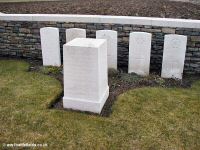
Special memorials at Neuve Chapelle British Cemetery
Further north is the second Cemetery, Neuve Chapelle Farm Cemetery. This is located in what was No Mans Land before the battle started, down a path off the Rue du Moulin. This is again located in a ploughed field, but new housing is springing up all around. On my most recent visit in May 2007, the cemetery is now reached by a tiny grass track which squeezes between two new houses. This is a small, narrow cemetery and the graves are arranged more or less in three long rows from back to front, with special memorials along the right hand side. There are two sets; to 6 and then to 7 Kensington men who are known to be buried in the cemetery, but the location of whose graves is not now known.
There are only 35 identified graves out of 60 soldiers who are buried here. Of these, all except one date from the time of the Battle of Neuve Chapelle, and many are the graves of men of the 13th London (Kensington) Regiment, who started the cemetery during the battle. There are also a small number of graves from other regiments involved in the battle (such as the Lincolns and the Royal Irish Rifles). The only exception is the grave of a soldier of the Wiltshire regiment, which dates from September 1918. Their Regimental History describes the Kensington's experiences during Neuve Chapelle. C Company was involved on the first day, and advanced at 9 a.m. to the village cemetery, where they had to take cover amidst churned-up graves. On the 12th of March, their C.O. (Lieutenant-Colonel Lewis) noted that by 12.25 p.m. the German bombardment of their positions (in the old front line) was "Perfect Hell". The bombardment lasted for nine hours, and this ordeal can only be imagined. On the 14th of March, as the battle fizzled to a close, 53 year old Captain Arthur Prismall commanding B Company was killed. He is buried here, in Neueve Chapelle Farm Cemetery. His son had joined the regiment just two days before.
Many men and officers from the units which took part in Neuve Chapelle are buried in a number of other cemeteries in the surrounding villages, but Neuve Chapelle Farm Cemetery is a little like Luke Copse Cemetery on the Somme or Spanbroekmolen Cemetery in the Ypres Salient. It is a small, original cemetery, where men who died during the battle were buried soon after by their comrades. It is a moving location to remember them.
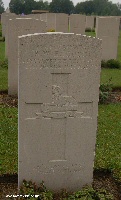
Neuve Chapelle Farm Cemetery: one who fell in the battle
As new buildings are constructed in the area, the signs of the battle fought here reappear from the earth. During my visit, there were piles of spoil near several of the half-built houses as a result of the building, and in just a couple of minutes I found numerous ammunition rounds and twisted pieces of rusty metal (probably shell fragments) in one of these.
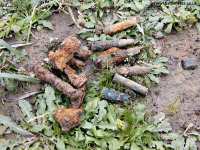
Bullets and other battle debris near Neuve Chapelle Farm Cemetery
Near another spoil heap was a rusted barbed wire picket, which could have been one of those brought up to consolidate the new lione after the battle. Even after ninety years, the signs of battle are not far beneath the surface here.
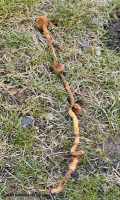
Barbed wire "silent picket" near Neuve Chapelle Farm Cemetery
Other sites around Neuve Chapelle
At the end of the Sunken Road was another feature of the 1915 battlefield - the "Ducks Bill" Today this is a small piece of woodland, although new houses have been built fairly close to it. Just near this, in the middle of a field are some bunkers; however they are not associated with the 1915 battle. They are not readily accessible, and cannot be seen in detail from the road.
Turning right at the Ducks Bill, and then left leads across another important feature on the 1915 battlefield - Layes Brook. This was a small stream which ran across the line of the intended advance, to the east of the village. This was swollen by the rain and snow before the battle, and was much more of an obstacle for the advancing troops than it might appear today.
After crossing Layes Brook, taking a right turn at the end of the road leads to the woodland known as the Bois du Biez. This wood was an objective but was not taken during the battle, but is an interesting site to walk around. One can walk around the left hand (or north-eastern) side of the wood along a track. The ground within the wood is uneven and overgrown. The track follows the side of the wood, and at the back (that is, the side furthest away from the village of Neuve Chapelle) curves to the right to follow the edge of the wood round. Just inside the wood at the north-eastern corner is a large bunker.
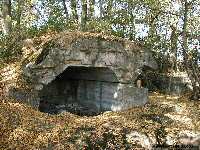
Large bunker at NE corner of the Bois du Biez
Following the track in a south-westerly direction, several more bunkers can be seen just inside the wood. These all date from later than the 1915 battle, and are not associated with it. The bunkers are in various states of repair; some almost complete and other almost totally collapsed.
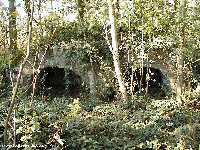
Another bunker in the Bois du Biez
The track then joins a road which runs along the back of the wood. Another road runs through the centre of the wood north-west towards the village. A little further past this turn, near a cinder track and football pitches, is a larger bunker located right on the edge of the wood. It may be nearly hidden in undergrowth depending on the time of year.
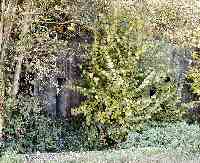
Bunker on the edge of the Bois du Biez
It is possible to enter this bunker through the doorways, and the interior is a n oppressively small space, now unfortunately covered in modern graffitti.
Sources & Acknowledgements
O.F. Bailey & H.M. Hollier "The Kensingtons" 13th London Regiment
Geoff Bridger The Battle of Neuve Chapelle
Commonwealth War Graves Commission website
Edmonds Military Operations in France & Belgium, 1915 Volume 1
Major & Mrs Holt's Battlefield Guide: The Western Front - North
National Archives, Kew: War Diaries of Brigades and Battalions, other files


